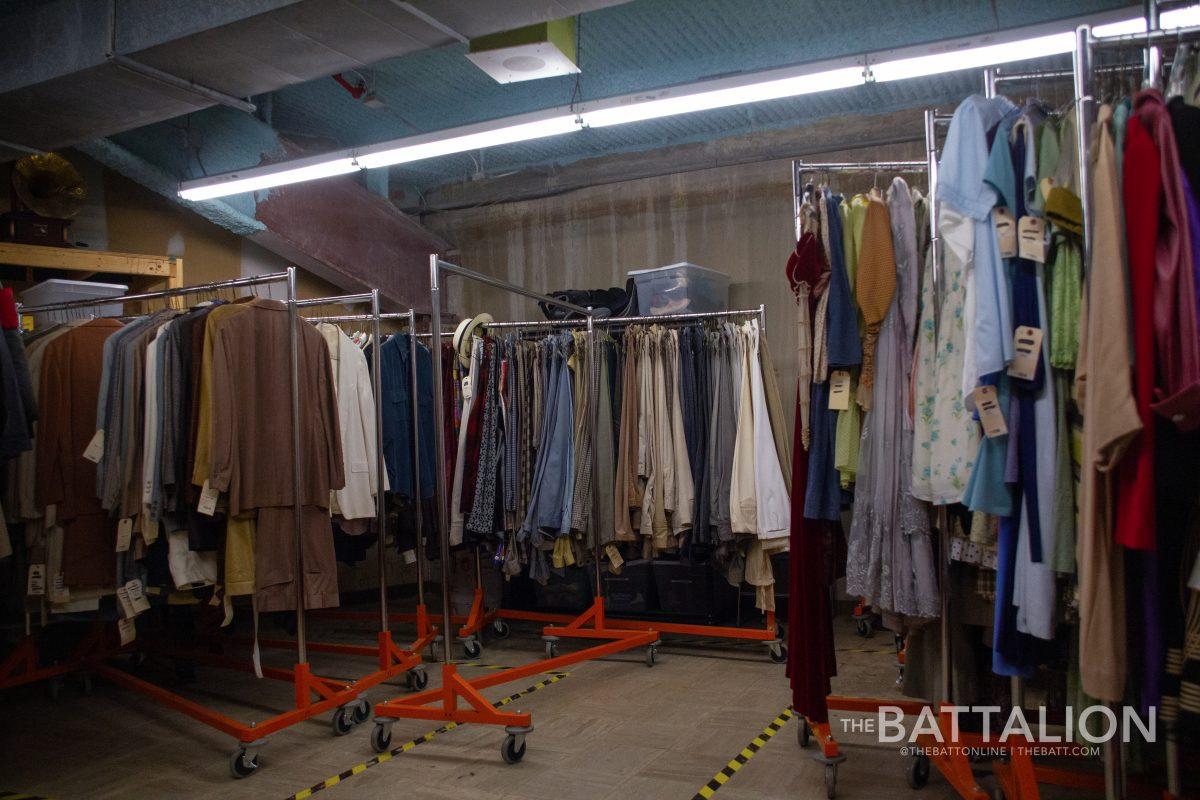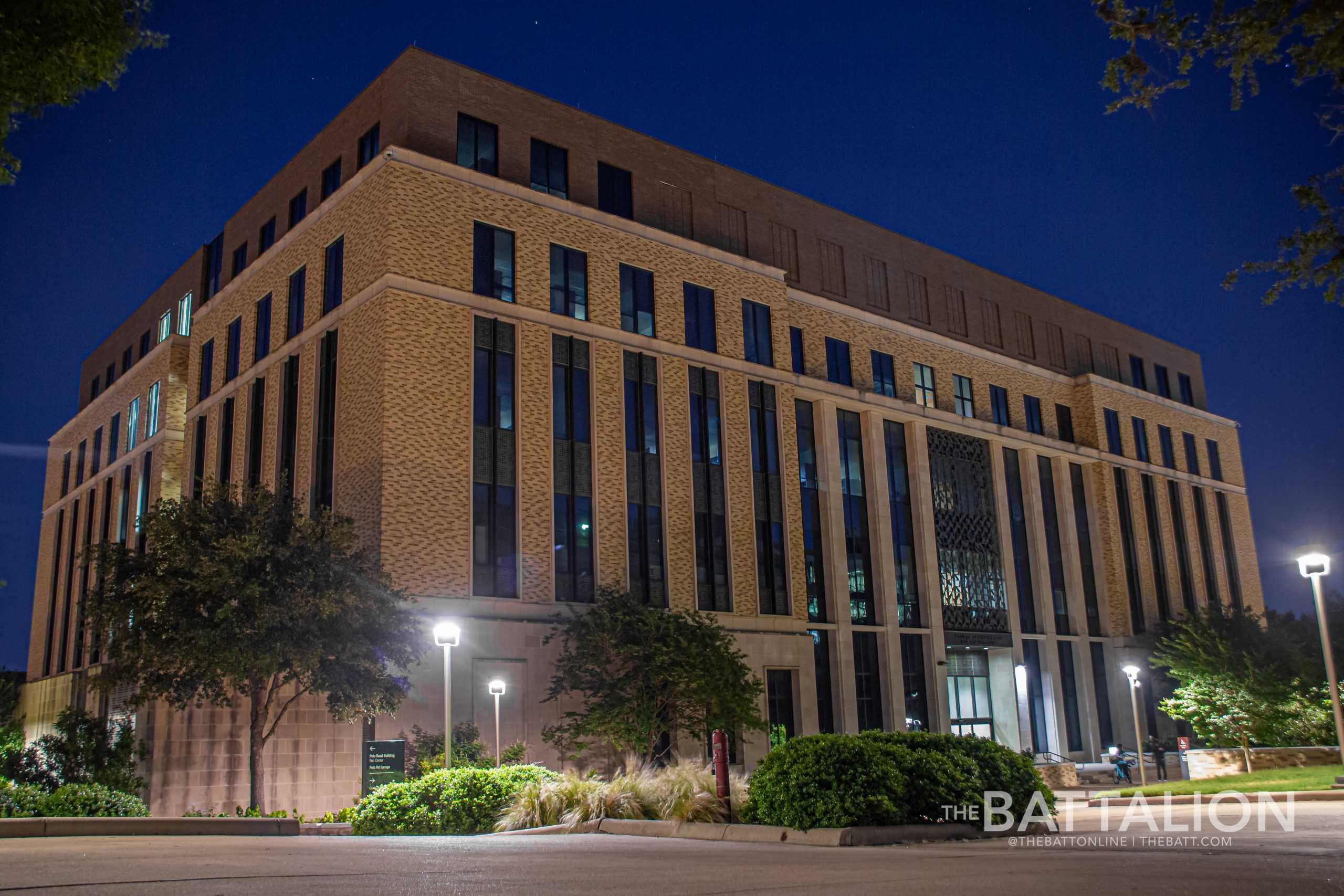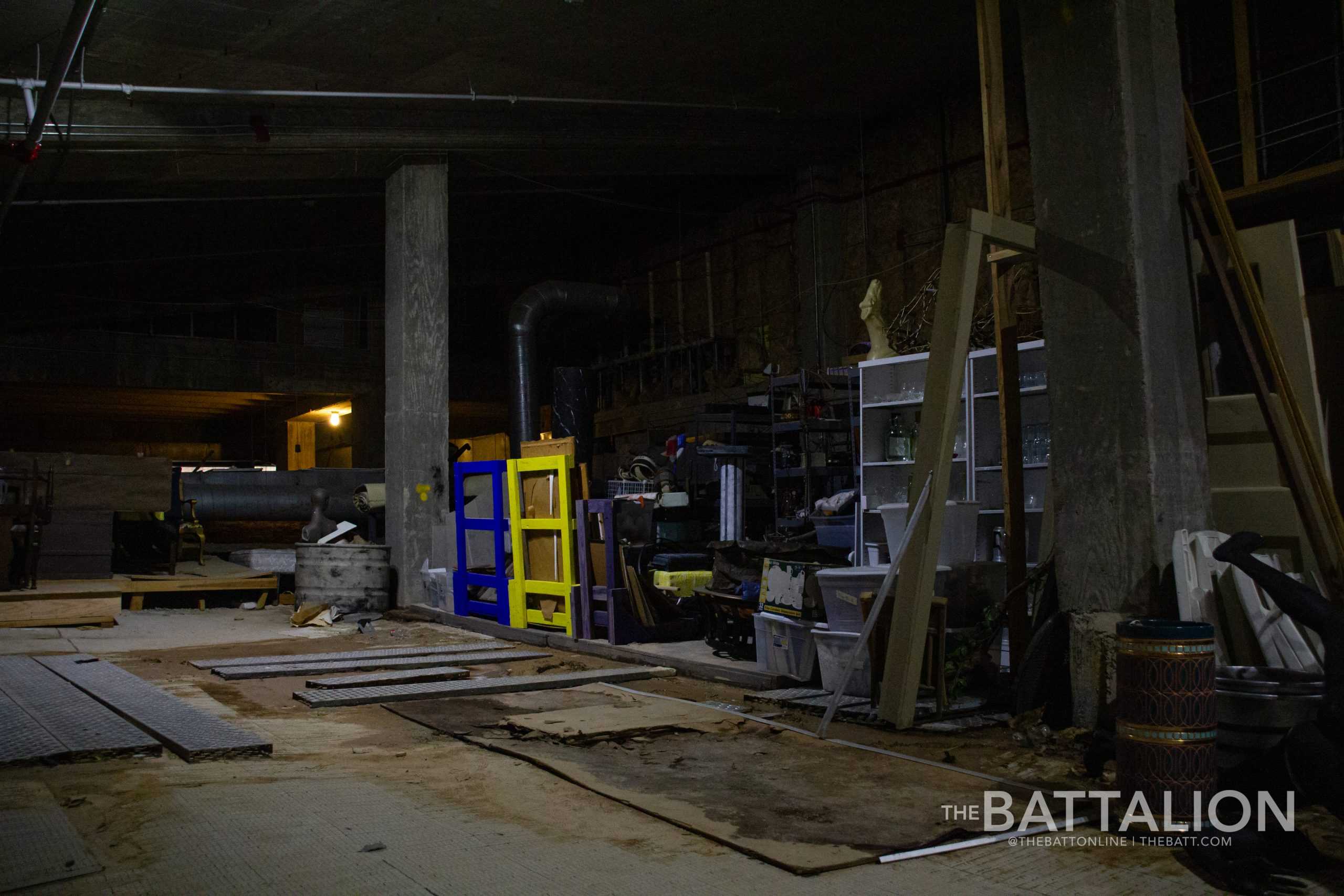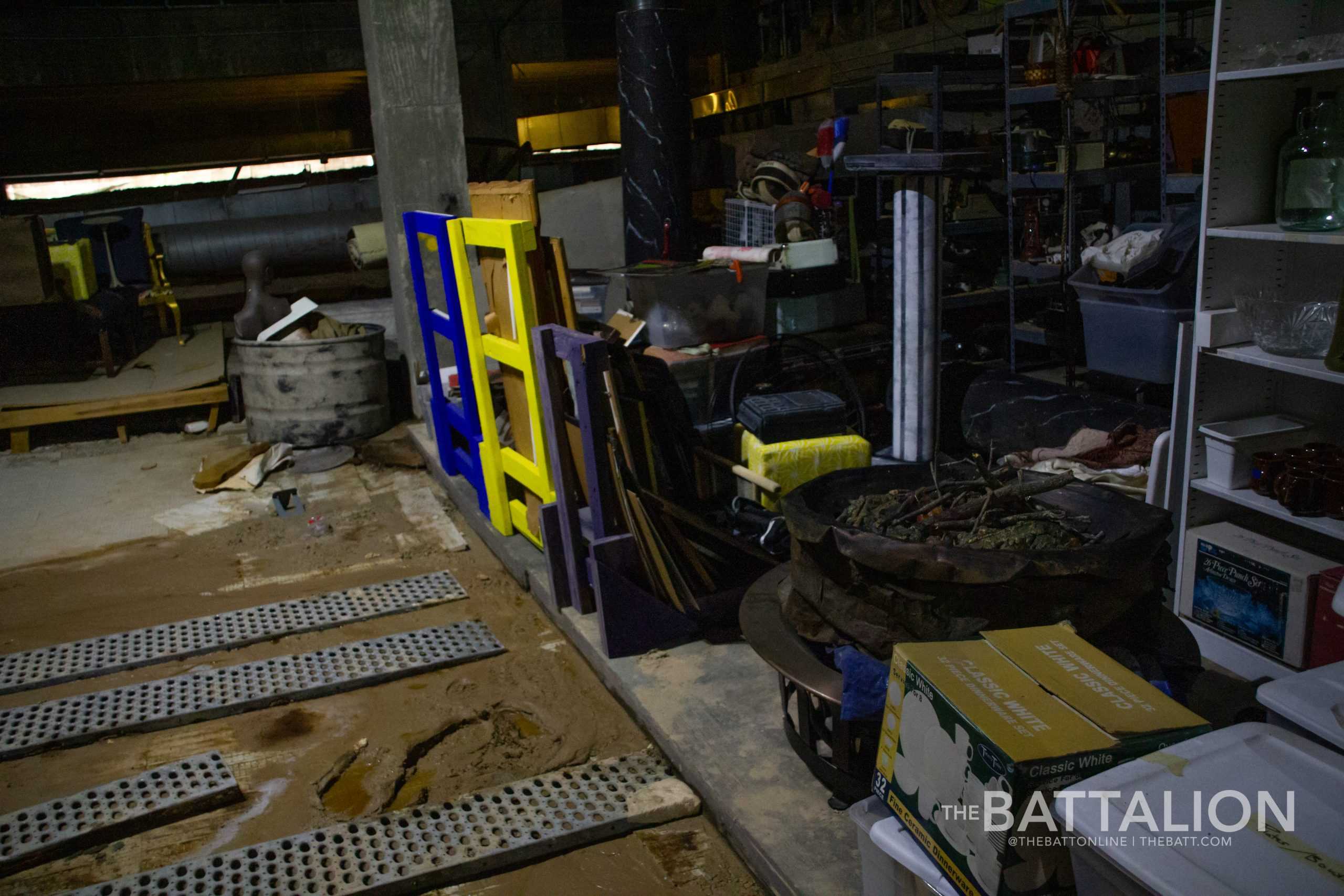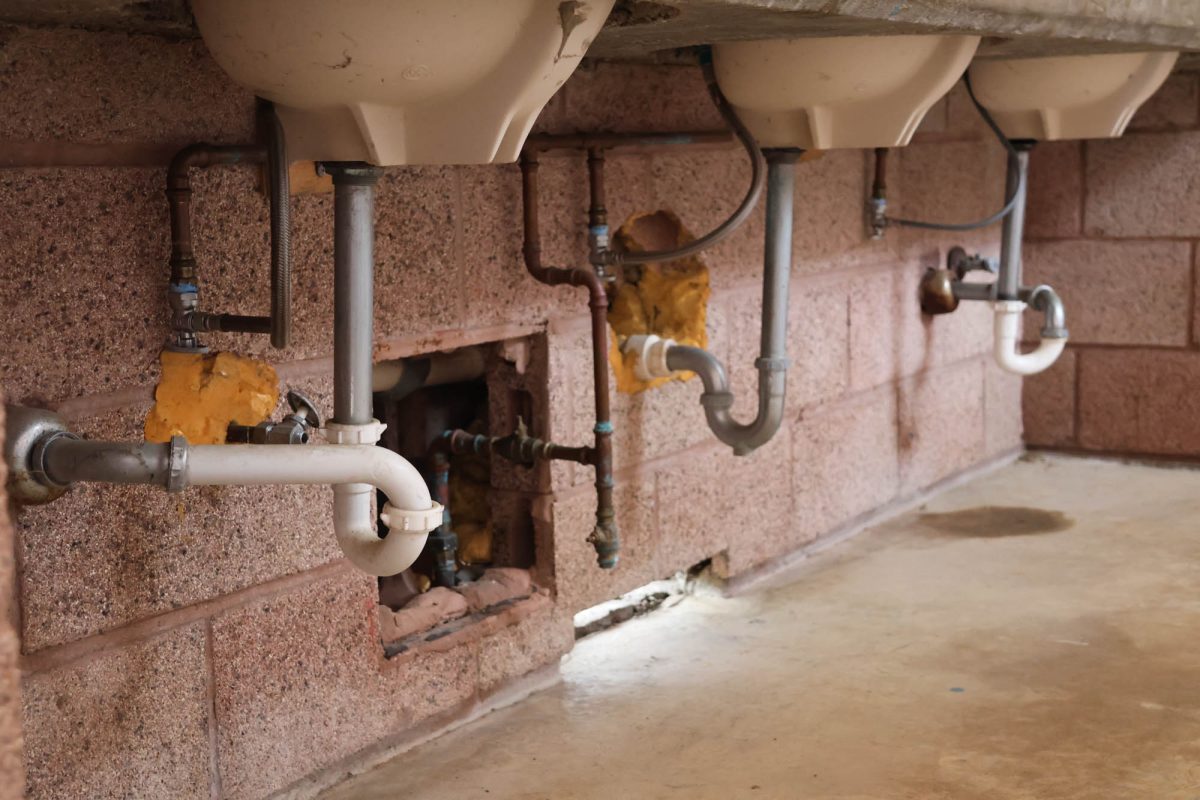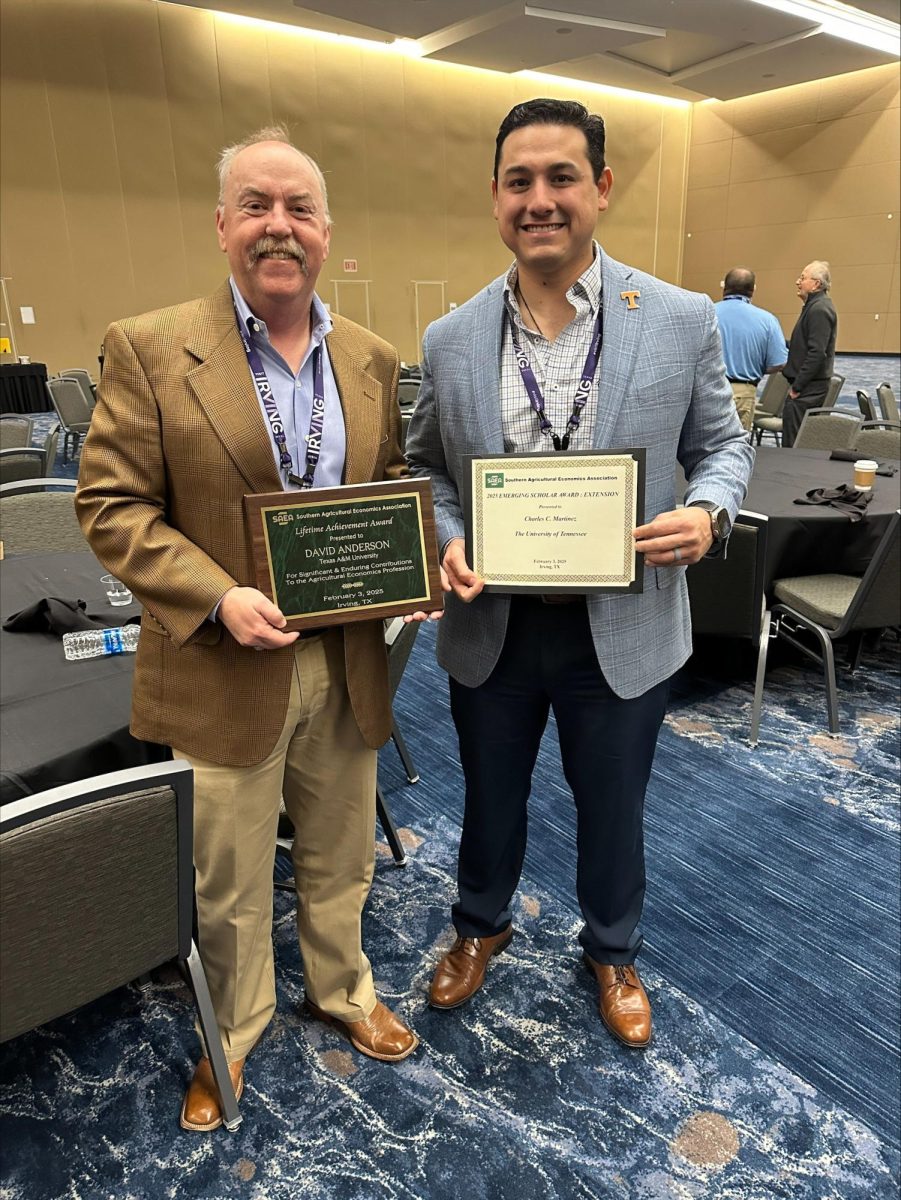Editor’s Note: This article has been updated since original publication to reflect corrections.
Texas A&M’s Department of Performance Studies uses a dirt floor basement under the Rudder Theatre Complex. The entryway begins at an unsuspecting wooden door, designed to blend into the auditorium exterior wall. On the other side is a metal scaffold, with stairs leading 6 feet underground. At the bottom, plastic mats cover a soil floor, which slopes upward toward a slanted ceiling braced with several wooden beams – the underside of the auditorium seats.
“You can see daylight, so when it rains, it floods,” Olivia Parker, president of theater organization Alpha Psi Omega and performance studies senior, said. “All our stuff is on pallets and risers to keep it from getting wet.”
Not surprisingly, two days after major rainfall, mud was still caked around the temporary flooring. Despite being lifted onto risers, water marks and mud stains can be seen on the surface. One wonders the basement’s condition beforehand, when Rudder staff twice turned away The Battalion for pictures.
Even A&M library basements, which house sensitive archival material, were criticized in a May 2 report from MGT of America Consulting and Martin+Crumpton Group.
“Storage and the location of some valuable items in less-than-ideal locations such as basements need to be addressed,” the document reads.
Completed in 1974, the complex has hosted major theater and musical productions at A&M. With 3,500 seats across three indoor venues, storage is crucial, especially when Broadway productions make their way to College Station. As recently as 2014, A&M’s departments of Performance Studies and Music Activities also used Rudder for their shows, but stopped after the programs were eliminated.
University President M. Katherine Banks’ “Path Forward” initiative includes a proposed School of Visual and Performing Arts, which would help satisfy the needs of A&M theater students, but performance studies majors are skeptical of whether the investment will be enough.
Between 1999 and 2012, the music and theater arts programs had facilities in five campus buildings: Blocker, Academic and Reed McDonald, with practice rooms in L.F. Peterson and costume storage in the Engineering Innovation Center. For maximum efficiency, the facilities needed to be localized.
The Liberal Arts and Arts & Humanities Building, or LAAH, was an attempt at just that. Built in 2012, LAAH unified the decentralized Department of Performance Studies. In 2014, the theater and music programs were removed from A&M curricula, based on that year’s “Academic Program Report,” or APR.
The APR is a normal process that university departments go through about every seven years. These documents, developed by the A&M Office of Academic Affairs, provide an in-depth analysis of a department’s history, statistics and potential for growth. Suggested in the 2014 report was a bachelor’s degree in performance studies, which, despite the department’s title, did not exist at A&M.
To achieve this goal, the theater arts and music programs were combined. Students from both programs were “taught out,” meaning they would be the last classes to graduate with a bachelor’s degree in theater arts or music.
“I don’t think the majority of students and faculty felt as if we contributed to that decision in meaningful ways,” Rayna Dexter, an instructional assistant professor in performance studies and active faculty member during the restructuring, said.
Dexter helped plan LAAH during its construction. Decisions ranging from carpeting choices to the inclusion of an in-house costume shop were thanks to her input. Other facilities such as practice rooms and a black box theater were included, but not laundry or prop storage.
“I was told that laundry facilities and storage were things that were non-negotiable, were not going to be put into that building,” Dexter said.
The reason given was that these resources existed elsewhere, she said.
Instead of moving these resources to LAAH, the new performance studies program found costume storage and laundry space in graphic services, a building across from Blocker and conjoined with Reed McDonald. The program had a large dye vat and two pairs of washers and dryers. By 2016, they were told to move again.
Before the theater arts program was removed, national honor society Alpha Psi Omega, or APO, also used Rudder for their productions. After theater arts was folded into the Department of Performance Studies, the organization was barred from performing free-of-charge. The only space still freely available to the department and APO is the “dirt storage basement,” a colloquial term for the storage sublevel of the Rudder Theatre Complex.
Since its second move in 2016, APO has used the dirt storage basement to house props and furniture. Even with equipment wagons, the half-mile walks between LAAH and Rudder, up and down basement stairs, before and after each night’s shows have been burdensome for APO members, Parker said.
As for the laundry equipment, while LAAH has a complete costume shop, there is still no plumbing for the relocated washers and dryers. Three pairs of washers and dryers reside in the Rudder Theatre Complex, but are exclusive to the building’s needs. Dexter, who is also the APO adviser and costume director, takes all costumes to a dry cleaner and laundromat by herself.
“The running joke here is ‘Yeah, we don’t get looked at,’” Grace Harmon, an APO member and junior performance studies major, said. “If we want help from the other side, as far as north and west campus goes, it will take a week, at least.”
Harmon said the College of Liberal Arts is a self-sustaining ecosystem, and credited LAAH proctor Jeff Watson as a key leader in that effort. Watson was a major figure during the early days of COVID-19, tasked with managing limited resources and ensuring the health and safety of anyone on-site. Then and now, Watson personally helps students with their ongoing projects and remains available to anyone who needs him.
The labor of faculty members like Watson and Dexter was juxtaposed last month, when recipients were chosen for President Banks’ Meritorious Awards. Out of the 25 individuals who received $1,000, a plaque and lapel pin, none of the recipients were from the College of Liberal Arts. The same can be said of the two supervisors and two teams who received the award. At least 10 recipients work in a science division, another 10 in administrative positions and two in the Mays Business School. One individual, Chandler Nichols, works for the University Libraries, another department facing extensive restructuring.
“Whether it was intended or not, it reflects something,” APO President Parker said.
The exclusion of the liberal arts college from the Meritorious Awards demonstrates A&M’s lack of attention, Harmon said.
“We don’t give good statistics, so why would they recognize any of it?” Harmon said. “When, in reality, these people that had to work here through the pandemic held this together with their own hands.”
Working Group 10, one of several committees tasked with fulfilling President Banks’ “Path Forward,” is currently developing a proposed School of Visual and Performing Arts. Similar to Mays Business School, this new division would operate separately from any college, and is intended to house all the facilities needed by the Department of Performance Studies. Plans to transfer KAMU, 12th Man Productions and The Battalion to the building are also proposed in the original MGT report.
However, the new school will be composed of the departments of Performance Studies, Dance and Visualization, consolidating those departments.
Editor’s Note: A previous version of this article stated the Performance Studies, Dance and Visualization programs would end. This has since been updated to clarify it will be the departments, rather than the degrees themselves, which will be consolidated.
The decision to combine these departments was derived from the 2021 comprehensive MGT report. This report features a list of administrative options for Banks, who developed the “Path Forward” initiative to implement these suggestions. University departments were not involved in drafting the MGT or the “Path Forward.” Nonetheless, select faculty members have joined working groups to make these suggestions a reality.
James R. Ball III is an associate professor in the Department of Performance Studies, director of the Academy for the Visual and Performing Arts and member of Working Group 10. His comments are his own, and do not reflect the views or plans of Working Group 10, A&M administration, or any other organization, he said.
Ball, who has a Ph.D. in performance studies, was hired in 2015, largely due to the development of the performance studies bachelor’s degree. According to Ball, there are no current plans to revive the theater arts or music bachelor’s degrees.
“There’s a variety of other degrees that we expect to build, but a priority for everyone is interdisciplinary work and imagining new interdisciplinary degrees,” Ball said.
Ball said Working Group 10 is looking at visualization curriculum, which combines art and technology, as a guide for the new school, and is interested in developing “practice-oriented” degrees.
“We’re all interested in expanding the focus on arts practice,” Ball said. “The natural degree to make, in that case, is a fine arts degree, which is a very different degree with very different expectations.”
The Department of Visualization is top of mind for Working Group 10, described by the MGT report as the intended “cornerstone” of the new school. About 60 faculty members will transfer to the new school, 30 from visualization, 20 from performance studies and less than ten from dance science. Associate professor for the Department of Visualization Tim McLaughlin was announced as the school’s new dean on April 28.
Despite this decision, most of the facilities planned for the new school are intended for performance arts. Ball said performance arts will require larger spaces, but only to serve as a “public-facing performance arts center,” used by the larger Bryan-College Station community.
“It will be the space in which the programming from OPAS happens,” Ball said. “I expect it will have some of its own programming, when it gets off the ground. If you need a 1,500-seat performance venue, that’s going to take up more space than a motion capture studio.”
And, not to be forgotten, the elusive storage and laundry facilities.
“None of our units have enough storage, and storage is the thing that always gets planned for,” Ball said. “Storage and laundry facilities. They are part of the equation.”
However, the working group has not developed a timeline for the construction of the new school. All developments are based on ongoing conversations. “Come September 1, we expect to all be part of the new school of the arts, even though we won’t have a building yet,” Ball said.
While faculty will begin developing programs, familiarizing themselves with visualization, hiring new faculty and continuing to plan the School of Visual and Performing Arts, the building itself is expected to take five years to complete. That’s another five years of dirt storage and personal laundering for performance studies.
“It’s certainly going to be complicated,” Ball said. “Our history of performance studies has been one of changing, pretty regularly. I think that this new change will provide challenges and it will provide other opportunities as well.”
The main group and subcommittees for bylaws, building development, curriculum and tenure are keeping A&M’s diverse student body in mind, Ball said. Anti-racist language in the school’s proposed bylaws, naming opportunities for the new performing arts center and the promotion of diverse faculty are key elements being discussed by the group.
“Old-style, conservatory theater systems are not the best at encouraging diversity,” Ball said.
He said he believes building the school from scratch is also an opportunity to develop new considerations for performers of varied backgrounds.
“Those answers are what I see us doing and what I think that we need to do. I think we can always do more,” Ball said.
As for the professional background of the working group, several members have little to no background in the arts, including the group’s chair, Greg Hartman. Hartman is A&M’s vice chancellor for Strategic Initiatives, and is experienced in developing new university divisions, but has little experience with performance studies.
“All curriculum questions are coming out of faculty that have the relevant expertise,” Ball said. “Everyone comes in with ideas, and everyone shares. And their perspectives are important, because we need those laypeople perspectives.”
“To make a successful school, we need to be speaking to those audiences as well as the academic audiences,” Ball said.
While Dexter doesn’t regret the creation of a performance studies major, she said she is much more enthusiastic about the faculty’s involvement in the working group. As opposed to the theater arts department’s lack of agency during the 2014’s restructuring, she said she feels that “meaningful contributions” have been made by the current performance studies faculty.
The working group has also reached out to APO, which Parker said she is very grateful for. Parker has been president for two years and a member since 2018. She is also a former classmate of Madison Murrah, Class of 2019, former APO member and member of Working Group 10. Murrah talked to Parker about APO’s unaddressed needs: time, people, and money.
“Some of them would be solvable with more university support, but that’s obviously not something we have the power to change right now,” Parker said.
“Even if we had all the funding, we would never get all the support,” said Harrison Daniels, an APO member, former Corps of Cadets member of Company E-2, and performance studies senior said.
“If we emphasized and rewarded the arts program, like we did with engineering or other schools – ‘25 by 25,’ or something like that – and we recruited for it, and advertised for it, and actually cared about it, then yes, we could have a good arts program, but arts are simply kicked and put to the side,” Daniels said.
Daniels said he believes that developing “outstanding alumni” and extending the Aggie network is the best way forward for the new school.
Harmon, however, said she believes that a school headed by current performance studies faculty would set the new school up for success, but a niche curriculum would be the best way to differentiate A&M’s arts programs to Parker.
“That’s not only a thing to make us successful, that’s something necessary,” Ball said. “Any new program that we develop has to be approved by the Texas Higher Education Coordinating Board. Part of their charge, as I understand it, is to make sure universities in the state are not unduly competing with each other.”
Dexter said that the resources to make a successful new school are already available.
“I don’t want to look back,” Dexter said. “I don’t want to look west and try to compete with other folks who are our neighbors. We have the opportunity to be interdisciplinary in a way that those older programs at other schools don’t get to.”




